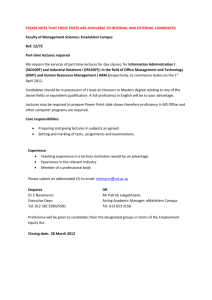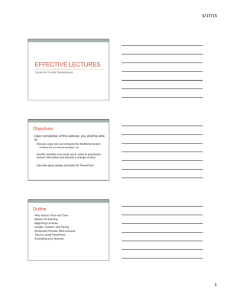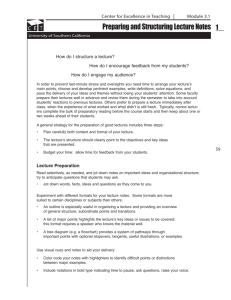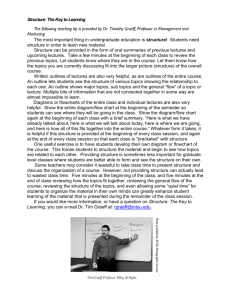Improving Lectures - I-Tech
advertisement
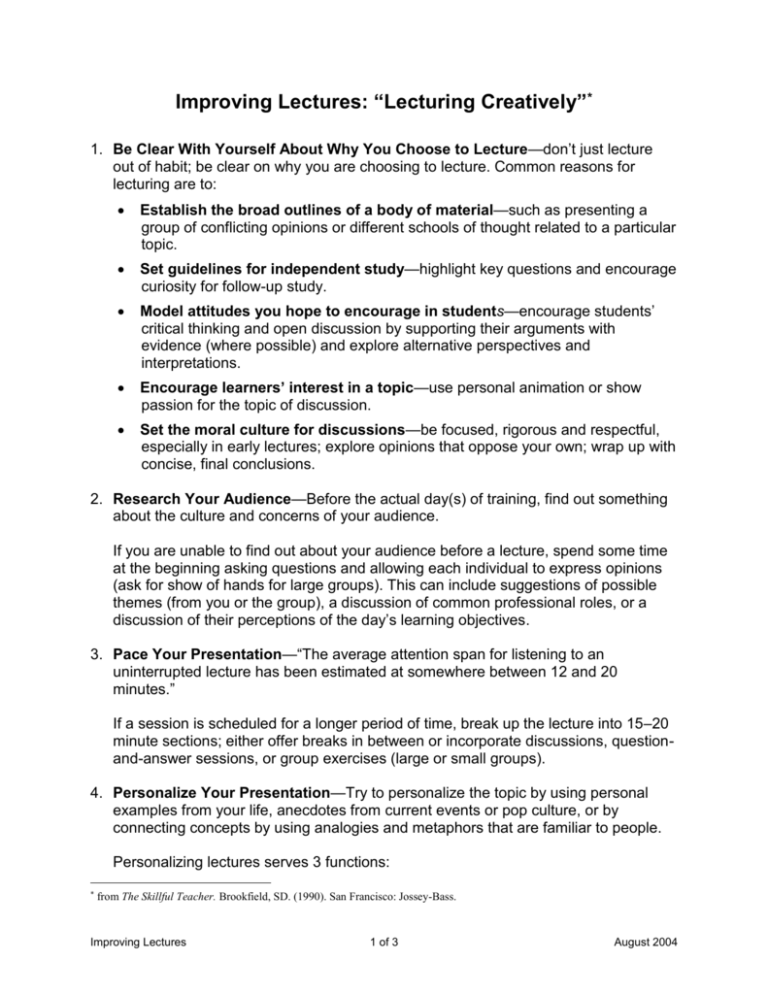
Improving Lectures: “Lecturing Creatively”* 1. Be Clear With Yourself About Why You Choose to Lecture—don’t just lecture out of habit; be clear on why you are choosing to lecture. Common reasons for lecturing are to: Establish the broad outlines of a body of material—such as presenting a group of conflicting opinions or different schools of thought related to a particular topic. Set guidelines for independent study—highlight key questions and encourage curiosity for follow-up study. Model attitudes you hope to encourage in students—encourage students’ critical thinking and open discussion by supporting their arguments with evidence (where possible) and explore alternative perspectives and interpretations. Encourage learners’ interest in a topic—use personal animation or show passion for the topic of discussion. Set the moral culture for discussions—be focused, rigorous and respectful, especially in early lectures; explore opinions that oppose your own; wrap up with concise, final conclusions. 2. Research Your Audience—Before the actual day(s) of training, find out something about the culture and concerns of your audience. If you are unable to find out about your audience before a lecture, spend some time at the beginning asking questions and allowing each individual to express opinions (ask for show of hands for large groups). This can include suggestions of possible themes (from you or the group), a discussion of common professional roles, or a discussion of their perceptions of the day’s learning objectives. 3. Pace Your Presentation—“The average attention span for listening to an uninterrupted lecture has been estimated at somewhere between 12 and 20 minutes.” If a session is scheduled for a longer period of time, break up the lecture into 15–20 minute sections; either offer breaks in between or incorporate discussions, questionand-answer sessions, or group exercises (large or small groups). 4. Personalize Your Presentation—Try to personalize the topic by using personal examples from your life, anecdotes from current events or pop culture, or by connecting concepts by using analogies and metaphors that are familiar to people. Personalizing lectures serves 3 functions: * from The Skillful Teacher. Brookfield, SD. (1990). San Francisco: Jossey-Bass. Improving Lectures 1 of 3 August 2004 It helps to provide familiar, accessible points of entry for complex ideas. It captures the attention of an audience to see someone speaking from personal experience. Talking publicly about aspects of your life outside of your role as a trainer or clinician helps to create credibility and helps connect with your audience. 5. Speak from Notes—versus speaking from, and strictly adhering to, pre-written scripts. Skeleton notes are carefully drawn up and give you an ordered, systematic progression of ideas and allow you freedom to digress. Give yourself permission to incorporate audience questions and discussion without feeling overwhelmed because you strayed from the script. Know that you have thorough knowledge of the topic so that a word or phrase from your notes will trigger ideas and associations. 6. Use Visual Aids—Use graphic depictions of main points to demonstrate the connection between them in an appealing way. This will be especially helpful to those who are primarily visual learners. Consider distributing copies of visual aids at the end of a lecture—be sure to tell your audience this at the beginning of the presentation so they don’t spend time trying to copy your words. However, some participants will prefer that you provide them with copies, for example, of PowerPoint slides so they can make their own notes as you speak. 7. Use Critical Incidents—Critical incidents, or case studies, are brief, written (or spoken) depictions of typical clinical events that participants are likely to see in their practice. This kind of training method requires that audience members be able to relate to the incident described and use what they are learning to analyze the situation. Avoid this technique if the audience has little or no knowledge or experience with the topic. If the participants do have prior experience with, for example, HIV patients, ask them to share their own cases with the group. 8. End the Session With a Question—Conclude your training with questions about the topic you’ve just discussed. Don’t be afraid to play the devil’s advocate (i.e., give the other side of a perspective or opinion) on some of your own points. This will encourage your audience to explore the topic further and ask questions. 9. See Yourself as Your Audience Sees You—Find ways to observe, and improve upon, your own lecturing. Improving Lectures 2 of 3 August 2004 This can be done by audience evaluation, informal discussion with audience members, or by videotaping yourself and reviewing the tape for behaviors that may be distracting for the audience. You can also audiotape yourself and make improvements in your verbal pacing, pitch, and delivery. Another option is to have a friend or colleague observe you and provide you with constructive feedback. Improving Lectures 3 of 3 August 2004




